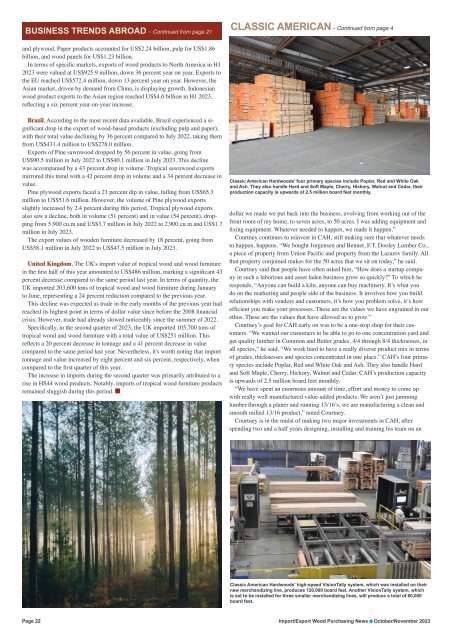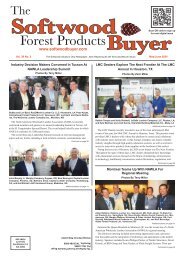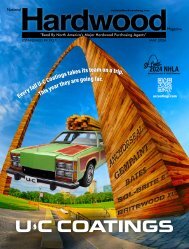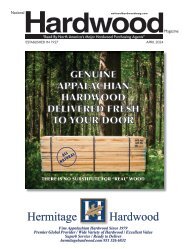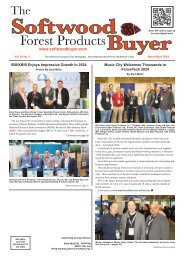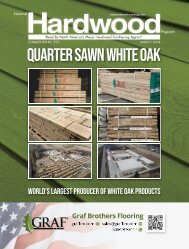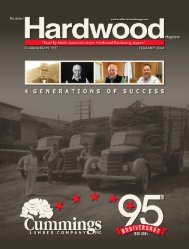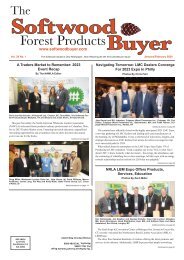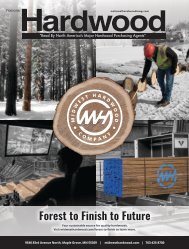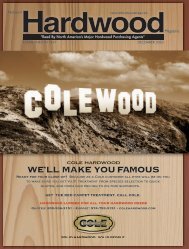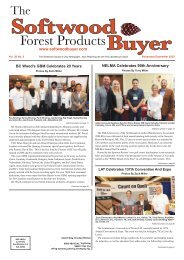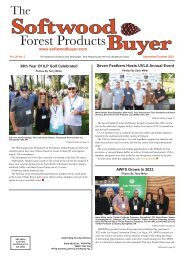Import/Export Wood Purchasing News - October/November 2023
The October/November 2023 issue of Import/Export Wood Purchasing News features stories on the AWFS Fair, the American Hardwood Export Council's Tecno Mueble, Classic American Hardwoods and Rainey Millworks. Check out the issue for the latest import/export industry news, too.
The October/November 2023 issue of Import/Export Wood Purchasing News features stories on the AWFS Fair, the American Hardwood Export Council's Tecno Mueble, Classic American Hardwoods and Rainey Millworks. Check out the issue for the latest import/export industry news, too.
Create successful ePaper yourself
Turn your PDF publications into a flip-book with our unique Google optimized e-Paper software.
BUSINESS TRENDS ABROAD - Continued from page 21<br />
and plywood. Paper products accounted for US$2.24 billion, pulp for US$1.86<br />
billion, and wood panels for US$1.23 billion.<br />
In terms of specific markets, exports of wood products to North America in H1<br />
<strong>2023</strong> were valued at US$925.9 million, down 36 percent year on year. <strong>Export</strong>s to<br />
the EU reached US$572.4 million, down 13 percent year on year. However, the<br />
Asian market, driven by demand from China, is displaying growth. Indonesian<br />
wood product exports to the Asian region reached US$4.6 billion in H1 <strong>2023</strong>,<br />
reflecting a six percent year-on-year increase.<br />
Brazil, According to the most recent data available, Brazil experienced a significant<br />
drop in the export of wood-based products (excluding pulp and paper),<br />
with their total value declining by 36 percent compared to July 2022, taking them<br />
from US$431.4 million to US$278.0 million.<br />
<strong>Export</strong>s of Pine sawnwood dropped by 56 percent in value, going from<br />
US$90.5 million in July 2022 to US$40.1 million in July <strong>2023</strong>. This decline<br />
was accompanied by a 43 percent drop in volume. Tropical sawnwood exports<br />
mirrored this trend with a 42 percent drop in volume and a 34 percent decrease in<br />
value.<br />
Pine plywood exports faced a 21 percent dip in value, falling from US$65.3<br />
million to US$51.6 million. However, the volume of Pine plywood exports<br />
slightly increased by 2.4 percent during this period. Tropical plywood exports<br />
also saw a decline, both in volume (51 percent) and in value (54 percent), dropping<br />
from 5,900 cu.m and US$3.7 million in July 2022 to 2,900 cu.m and US$1.7<br />
million in July <strong>2023</strong>.<br />
The export values of wooden furniture decreased by 18 percent, going from<br />
US$58.1 million in July 2022 to US$47.5 million in July <strong>2023</strong>.<br />
United Kingdom, The UK's import value of tropical wood and wood furniture<br />
in the first half of this year amounted to US$486 million, marking a significant 43<br />
percent decrease compared to the same period last year. In terms of quantity, the<br />
UK imported 203,600 tons of tropical wood and wood furniture during January<br />
to June, representing a 24 percent reduction compared to the previous year.<br />
This decline was expected as trade in the early months of the previous year had<br />
reached its highest point in terms of dollar value since before the 2008 financial<br />
crisis. However, trade had already slowed noticeably since the summer of 2022.<br />
Specifically, in the second quarter of <strong>2023</strong>, the UK imported 105,700 tons of<br />
tropical wood and wood furniture with a total value of US$251 million. This<br />
reflects a 20 percent decrease in tonnage and a 41 percent decrease in value<br />
compared to the same period last year. Nevertheless, it's worth noting that import<br />
tonnage and value increased by eight percent and six percent, respectively, when<br />
compared to the first quarter of this year.<br />
The increase in imports during the second quarter was primarily attributed to a<br />
rise in HS44 wood products. Notably, imports of tropical wood furniture products<br />
remained sluggish during this period. n<br />
CLASSIC AMERICAN - Continued from page 4<br />
Classic American Hardwoods’ four primary species include Poplar, Red and White Oak<br />
and Ash. They also handle Hard and Soft Maple, Cherry, Hickory, Walnut and Cedar, their<br />
production capacity is upwards of 2.5 million board feet monthly.<br />
dollar we made we put back into the business, evolving from working out of the<br />
front room of my home, to seven acres, to 50 acres. I was adding equipment and<br />
fixing equipment. Whatever needed to happen, we made it happen.”<br />
Courtney continues to reinvest in CAH, still making sure that whatever needs<br />
to happen, happens. “We bought Jorgensen and Bennet, F.T. Dooley Lumber Co.,<br />
a piece of property from Union Pacific and property from the Lazarov family. All<br />
that property conjoined makes for the 50 acres that we sit on today,” he said.<br />
Courtney said that people have often asked him, “How does a startup company<br />
in such a laborious and asset laden business grow so quickly?” To which he<br />
responds, “Anyone can build a kiln, anyone can buy machinery. It’s what you<br />
do on the marketing and people side of the business. It involves how you build<br />
relationships with vendors and customers, it’s how you problem solve, it’s how<br />
efficient you make your processes. These are the values we have engrained in our<br />
ethos. These are the values that have allowed us to grow.”<br />
Courtney’s goal for CAH early on was to be a one-stop shop for their customers.<br />
“We wanted our customers to be able to go to one concentration yard and<br />
get quality lumber in Common and Better grades, 4/4 through 8/4 thicknesses, in<br />
all species,” he said. “We work hard to have a really diverse product mix in terms<br />
of grades, thicknesses and species concentrated in one place.” CAH’s four primary<br />
species include Poplar, Red and White Oak and Ash. They also handle Hard<br />
and Soft Maple, Cherry, Hickory, Walnut and Cedar. CAH’s production capacity<br />
is upwards of 2.5 million board feet monthly.<br />
“We have spent an enormous amount of time, effort and money to come up<br />
with really well manufactured value-added products. We aren’t just jamming<br />
lumber through a planer and running 13/16’s, we are manufacturing a clean and<br />
smooth milled 13/16 product,” noted Courtney.<br />
Courtney is in the midst of making two major investments in CAH, after<br />
spending two and a half years designing, installing and training his team on an<br />
Merchandizing Line with 3D Board Scanner.<br />
integrated merchandizing production line, complete with two planers, an automated<br />
gang rip and a 3D scanner. “I wanted to be more efficient, quicker and<br />
better able to respond to our wide spectrum of our end-users and distribution<br />
customers in North America, as well as 42 different countries around the globe,”<br />
he said. Because of the systems that Courtney has invested in, it truly has made<br />
CAH a one-stop shop. “If a customer calls and needs a truckload of Poplar, 12’<br />
through 16’ gang ripped to 6-inches and surfaced, we can get it to them in two<br />
days. It’s not really hard for us because of the investments we’ve made to put<br />
these systems in place.”<br />
CAH makes sure that when a customer calls and wants something specific,<br />
they have it. “We have a million feet of lumber in the kilns at all times. We drop<br />
two kilns a day and so rarely is it that we don’t have 4/4 Red and White Oak,<br />
Poplar, Ash or Maple,” Courtney went on.<br />
Part of Courtney’s major investments is installing a Weinig high-speed moulder<br />
that can run 200 lineal feet a minute and take 12-inch boards or smaller. “We<br />
are planning on going after the S4S market pretty hard,” he remarked.<br />
Each investment that Courtney has made allows CAH to become more efficient,<br />
allowing lumber to move from the LICO system to the front of the moulder<br />
quickly. “The LICO system allows us to rip one edge, rip two edges, plane the<br />
lumber, or width sort it if needed all in one pass, providing CAH the ability to be<br />
a low cost high quality supplier to our valued customers. At the end of the day it<br />
is all about efficiencies.<br />
“We have 150,000 feet of lumber a day coming through our systems. We can<br />
rip exactly what we need to and have it go through the moulder the next day,”<br />
Courtney said. “We don’t have to worry about our product getting bottlenecked.<br />
We can take an order for mouldings on Monday and have a truckload produced<br />
by Friday.”<br />
One of Courtney’s goals for CAH is to have up to four operational moulders<br />
and an optimized chop line so that they are able to serve the S4S market as well<br />
as the moulding and millwork markets. “It takes a big place to hold all of this<br />
equipment,” he said. “That’s why over the past year and a half we have been<br />
tearing down old properties and building new ones. One of our newest buildings<br />
is 37,500 square feet and the equipment was installed lineally so we can be as<br />
efficient as possible.”<br />
As CAH continues to become more streamlined in all of their processes, they<br />
continue to become more reliable to their customers. A high-speed VisionTally<br />
system, which was installed on their new merchandizing line, produces 120,000<br />
board feet. Another VisionTally system, which is set to be installed for three<br />
smaller merchandizing lines, will produce a total of 60,000 board feet. CAH<br />
has not only added to their efficiency in processing lumber but selling it as well.<br />
“The distribution yards that we go into, they have a great business, and we have<br />
learned that the best way for us to service them is to provide the volumes that<br />
they need, in the way that they need them,” Courtney noted. This understanding<br />
of who their customers are is the exact reason why CAH does not ship standard<br />
packs. “For some customers, we provide 200-250 board feet in a pack with our<br />
toppers, cross outs and wide bands. This means our customers don’t have to<br />
worry about the cost of labor for peeling off 200 board feet from the truck and<br />
they have a pack with exactly what they need and everything that they want to<br />
carry, already milled.<br />
“We really try to hit our ship dates. Our customers have grown to depend on<br />
us delivering on time so that they don’t have their money tied up with too much<br />
YELLOW BIRCH HARD MAPLE SOFT MAPLE RED OAK<br />
WHITE OAK ASPEN WHITE BIRCH ASH WALNUT<br />
YELLOW POPLAR<br />
Continued on page 24<br />
Classic American Hardwoods' high-speed VisionTally system, which was installed on their<br />
new merchandizing line, produces 120,000 board feet. Another VisionTally system, which<br />
is set to be installed for three smaller merchandizing lines, will produce a total of 60,000<br />
board feet.<br />
| CANADIAN PRODUCT |<br />
CANADIAN PRODUCT | CANADIAN PRODUCT<br />
Page 22 <strong>Import</strong>/<strong>Export</strong> <strong>Wood</strong> <strong>Purchasing</strong> <strong>News</strong> n <strong>October</strong>/<strong>November</strong> <strong>2023</strong><br />
<strong>Import</strong>/<strong>Export</strong> <strong>Wood</strong> <strong>Purchasing</strong> <strong>News</strong> n <strong>October</strong>/<strong>November</strong> <strong>2023</strong> Page 23


